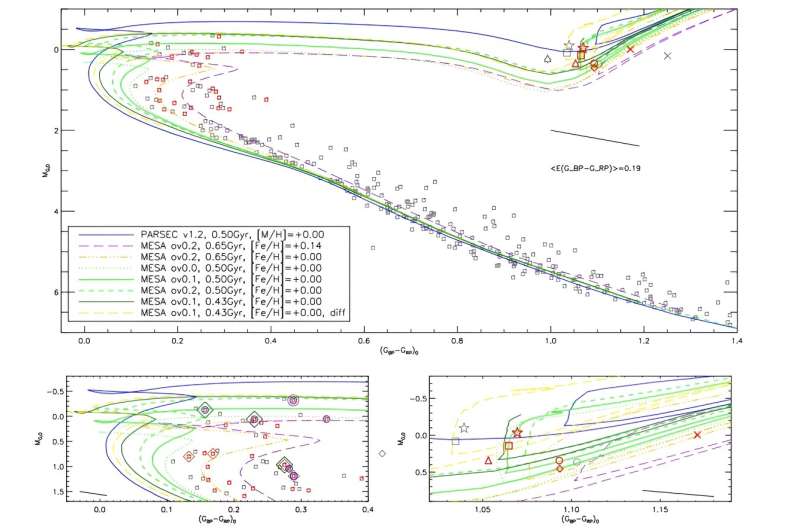September 4, 2023 report
This article has been reviewed according to Science X's editorial process and policies. Editors have highlighted the following attributes while ensuring the content's credibility:
fact-checked
preprint
trusted source
proofread
Astronomers investigate giant stars in open cluster NGC 6866

Using NASA's Kepler and ESA's Gaia spacecraft, an international team of astronomers has conducted an astroseismic investigation of six giant stars in the open cluster NGC 6866. The study, presented August 24 on the pre-print server arXiv, sheds more light on the properties of these giant stars and the cluster itself.
Open clusters (OCs), formed from the same giant molecular cloud, are groups of stars loosely gravitationally bound to each other. So far, more than 1,000 of them have been discovered in the Milky Way, and scientists are still looking for more, hoping to find a variety of these stellar groupings. Expanding the list of known galactic open clusters and studying them in detail could be crucial for improving our understanding of the formation and evolution of our galaxy.
Discovered in 1783, NGC 6866 (also known as OCL 183) is a relatively young (estimated to to be between 480 and 780 million years old) OC in the constellation Cygnus, at a distance of about 3,900 light years away. However, although the cluster is known for more than two centuries, many of its properties, including age are still uncertain.
That is why a group of astronomers led by Karsten Brogaard of the University of Bologna in Italy, decided to identify and investigate oscillating giant members of the open cluster NGC 6866, using them to constrain cluster properties. For this purpose, they analyzed the results from Gaia's Data Release 3 (DR3) and photometric light curves from the Kepler spacecraft.
"We identify six giant members of NGC 6866 via photometry, proper motions, and parallaxes from Gaia and spectroscopic literature measurements. These are combined with asteroseismic measurements which we derive using photometric data from the Kepler mission for five of the stars," the researchers explained.
The astronomers selected and examined six giant stars in the helium-core burning (HeCB) phase, namely: KIC 8461659, KIC 8329894, KIC 8395903, KIC 8264549, KIC 7991875 and KIC 8264592. All these stars have similar effective temperatures—at a level of 5,100 K.
The study found that the six giants have a mean radius of about 10.1 solar radii and a mean mass of around 2.8 solar masses. The astronomers underlined that the investigated stars are therefore significantly smaller than predicted by current one-dimensional stellar models.
According to the paper, the six stars were found to be between 443 and 580 million years old. By comparing all the collected data to stellar-model isochrones the age of NGC 6866 was estimated to be 430 million years, thus the cluster turns out to be younger than previously thought.
The researchers added that future asteroseismic missions, like the planned ESA's High-precision AsteroseismologY of DeNse (HAYDN) stellar fields, have the potential to uncover more details regarding the properties of stars in NGC 6866 and in other young open clusters.
More information: K. Brogaard et al, An asteroseismic age estimate of the open cluster NGC 6866 using Kepler and Gaia, arXiv (2023). DOI: 10.48550/arxiv.2308.12731
Journal information: arXiv
© 2023 Science X Network




















